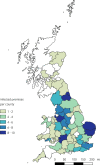An epidemiological overview of the equine influenza epidemic in Great Britain during 2019
- PMID: 36054725
- PMCID: PMC10087154
- DOI: 10.1111/evj.13874
An epidemiological overview of the equine influenza epidemic in Great Britain during 2019
Abstract
Background: During 2019, an epidemic of equine influenza (EI) occurred in Europe.
Objectives: To describe the epidemiology of the 2019 EI epidemic within Great Britain (GB).
Study design: Retrospective descriptive study of laboratory confirmed EI cases.
Methods: Epidemiological data were obtained from veterinary surgeons referring samples for EI virus testing. Where available, data on confirmed cases and their wider resident population on EI-infected premises were collated and described. On a national level, spatial and temporal representations, consisting of choropleth maps and epidemic curves, described the spread of EI. EI-infected premises-level factors associated with the first of two epidemic phases were investigated using ordinary logistic regression analysis.
Results: There were 412 confirmed cases and 234 EI-infected premises, with the first of two epidemic phases occurring between January and April, followed by a second phase through to August. The median age of confirmed cases was 5 years and Sports horses (24%) and Cobs (16%) made up the highest proportions by general horse type and breed. Among confirmed cases 72% were unvaccinated and 18% were vaccinated against EI. New horses arriving within 2 weeks of a confirmed case were reported by 42% of EI-infected premises. Investigation of EI-infected premises biosecurity measures indicated that 23% quarantined new arrivals, 37% had isolation facilities and 57% of resident horses were vaccinated. EI-infected premises were more likely in the first than second epidemic phase to be classified as professional, have a vaccinated confirmed case and EI confirmed in a newly arrived animal.
Main limitations: Data were collected at a single time point for each EI-infected premises with no follow ups performed.
Conclusions: During 2019, EI-infected premises generally had low levels of population vaccine coverage and implemented limited preventive biosecurity measures, particularly linked to horse movements. Without substantial improvements in infectious disease prevention and control, the GB equine population remains at risk of future EI epidemics.
Keywords: disease surveillance; epidemiology; horse; infectious disease; influenza.
© 2022 The Authors. Equine Veterinary Journal published by John Wiley & Sons Ltd on behalf of EVJ Ltd.
Conflict of interest statement
The authors declare no conflict of interest.
Figures



References
-
- Sellon DC, Long MT. Equine infectious diseases: second edition. Amsterdam: Elsevier; 2013. 10.1016/C2010-0-67112-4 - DOI
MeSH terms
Grants and funding
LinkOut - more resources
Full Text Sources
Medical
Miscellaneous

